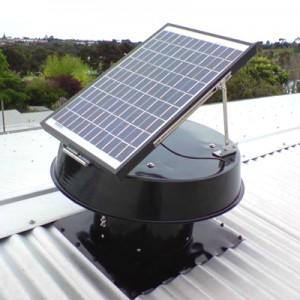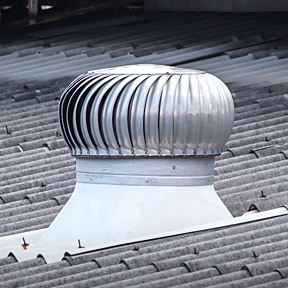Keeping your roof spaces cooler
In summer, the temperature of roof areas can get up as high as 60–70°C.[1] In addition to insulation and roof ventilation, the colour of the roof can play a key part in keeping your roof spaces cooler.
This section shows you how to keep the roof cool in your business premises.
How do whirlybirds work?
 A roof-mounted whirlybird uses wind power to remove hot air from enclosed attic and rooftop spaces. When they expel the hot air, the whirlybirds rely on the vents in your eaves to draw in the cooler outside air.
A roof-mounted whirlybird uses wind power to remove hot air from enclosed attic and rooftop spaces. When they expel the hot air, the whirlybirds rely on the vents in your eaves to draw in the cooler outside air.
Many business have used whirlybirds over the years, but some companies are now replacing them with solar-powered roof-cavity ventilators.
Solar-powered roof-cavity ventilator
Solar-powered roof-cavity ventilators have proven to be very effective in removing heat from enclosed roof spaces. The small solar panel drives the fan motor, which gives it a significant performance boost over the whirlybirds:
- The average whirlybird moves approximately 100m3/h (cubic metres of air per hour).
- Depending on the make and model, the manufacturer claims that a single solar-powered ventilator is “10-30 times more powerful” than a whirlybird.[2]
 It is far more effective in reducing the heat build up in your roof space. This can lead to lower air-conditioning cooling costs.
It is far more effective in reducing the heat build up in your roof space. This can lead to lower air-conditioning cooling costs.
One advantage of these units is that you can link them to a roof thermostat that starts to extract the air only when the temperature reaches a certain level.
This ensures that the unit doesn’t kick in on colder winter days, when you need the warmth to stay in your roof cavity.
An EcoSmart Electrician can give you professional advice about the various solar-powered and powered roof-cavity ventilator options for your roof space.
Matching ceiling vents to roof-cavity ventilators
 Within a business environment, there are many factors and appliances that generate heat. Rather than fully relying on your air conditioner, you can partially extract this heat using:
Within a business environment, there are many factors and appliances that generate heat. Rather than fully relying on your air conditioner, you can partially extract this heat using:
- a solar-powered ventilator on your roof
- ceiling grille vents in your business premises.
During hot summer days, these ceiling grilles can be left open. The hot air in your premises rises through the open ceiling grilles and the powered ventilator on your rooftop sucks the hot air out.
During winter, you can shut the ceiling grilles to keep the heat in. The thermostat can switch off the heat extractor on the solar-powered or powered ventilator during colder weather – this helps to keep any warm air in the roof space.
Hybrid Wind Ventilators with smart controls are able to monitor conditions inside and outside to make sure that you are not accidentally bringing in hot air from outside. This ensures that your ventilation system is only bringing in cooler air from outside. In winter it has a reverse setting which can bring in warmer air from outside when the conditions are right.
Ventilation and heat extraction systems
Australian-designed solutions that ventilate buildings and extract heat from the roof space include:
These products can make your premises more comfortable and will potentially cut your heating and cooling bills at the same time.
Duct insulation
In a lot of small businesses, the cooling ducts from the air-conditioning are located in hot roof spaces and are poorly-insulated. This can affect the cooling efficiency and running costs of the air-conditioning system. 
If you have air-conditioning ducts in your roof space, the way to solve this problem is to:
- improve the insulation on your air-conditioning ducts – this needs to be applied to the outside surface of the duct
- ensure that there are no air leaks from the ducts
- have a solar-powered ventilator to remove heat from the roof space.


